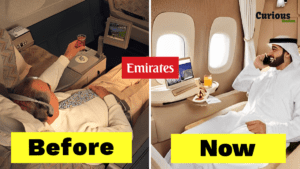Significant changes and improvements to international air travel and key traffic routes have been brought about over time by the entry of Middle Eastern airlines like Emirates, Etihad, and Qatar Airways. Emirates Airlines stands out as the most dominant airline in the Middle East among the main carriers. Emirates was a true success on a worldwide scale. In just 25 years, the airline had expanded to become the largest by the number of international passengers and the third-largest airline in the world by capacity.
With a 95,000-strong team that includes people from over 160 different countries, The Emirates Group now works on six continents and caters to customers’ demands of emailing, Internet browsing, or even just traveling between 150 locations. Returning to the 1980s, let’s examine how The Emirates attained this achievement and became one of the world’s largest airlines.
Gulf Air, a regional carrier sponsored by the nations of Bahrain, Oman, Qatar, and the emirate of Abu Dhabi, dominated the Middle Eastern aviation market in the 1980s. Even though some European airlines served the area, the market as a whole was limited, and Gulf Air continued to hold a good portion of the market. Most of its flights, which mostly used a point-to-point network, originated from its four hub cities and went to locations in the Middle East, South Asia, and Europe. Reduced air service to Dubai, a non-core city for Gulf Air, forced the city’s government to establish its own airline, Emirates Airlines, in 1985.
A division of “The Emirates Group,” which has been owned by the Dubai government since its founding in 1985, is Emirates Airlines. Due to the lack of local airline experience, the royal family hired a small group of seasoned international airline professionals, led by Sir Maurice Flanagan, to launch the service they called Emirates. According to the Divisional Senior Vice President (SVP) of Corporate Communications, Marketing & Brand Boutros Boaters, the service was expanded at a rapid rate in the ensuing years and reached Australia in 1996 as well as Australia in 1986 (Cairo), Europe in 1987 (Gatwick), East Asia in 1990 (Bangkok), and Africa in 1986 (Cairo) (Melbourne via Singapore). Emirates set its sights on increasingly many further locations to feed into its hub after establishing consistent development in the regional market.
When new aircraft technology permitted Emirates to launch direct non-stop service to New York and Sydney on the recently acquired Airbus A340s, the company’s focus on long-haul service officially began. By 2008, Emirates had overtaken all other airlines in terms of revenue passenger miles, and by 2013, it was flying to 138 different places on six continents. From a humble beginning, the airline quickly expanded to serve 39.4 million passengers, generate $19.9 billion in revenue, and employ 48,000 employees in just 28 short years. Additionally, it had successfully maintained operating profitability for 25 years running, which was an impressive performance in a sector of the economy that had historically failed to cover its cost of capital.
How did this company become the world’s largest airline with just $10 million as start-up capital?
Clearly, in the case of Emirates Airlines, Dubai’s hub located in the middle of the European and Australasian continents offers the airline plenty of advantages, as 3.5 billion of the world’s 7 billion inhabitants live within an eight-hour flying time of Dubai. Emirates also offers long-haul to long-haul traffic flows between Asia, Australia, and Europe to exploit this advantage.
The hub and spoke model is a system for connecting cities with a single, central hub to make it easier for people to travel around the world.
First of all, Dubai’s location on the Arabian Peninsula made it a critical crossroads for international trade routes linking Europe, Oceania, Asia, and Africa. Second, because it was relatively far from congested European airspace, there was little aviation traffic and flights could connect at nearly any time of day, enabling 24-hour operations.
Thirdly, airport operations in Dubai remained largely free of the rain and snow storms that frequently caused delays in European and American airspace, except for the rare fog and the general heat. It was no small achievement that around 40% of Emirates passengers began or ended their flights in Dubai: Dubai’s government had invested a lot of time and effort in growing the city’s tourism industry and positioning it as a transportation and logistics center.
Emirates has also been successful in achieving its goal of becoming an innovative, modern, and customer provider of premium air travel services. Emirates has successfully and consistently developed a customer-focused value proposition throughout the years by providing a variety of goods, services, information, and experiences that are tailored to the market demographics for each of its locations. In terms of In-flight Systems (Entertainment & Electronic Systems): Emirates was the first airline to install each of its seatbacks with a visual entertainment system in 1992.
Its onboard information, communication, and entertainment (ICE) system, an all-in-one communications device accommodating straight to the customers’ hotel, their next meeting, their favorite restaurants, or even to the course for a round of golf, was one of the many product offerings that resulted from this. Over 70 cities around the world make this service available. Regarding In-flight entertainment: All Emirates flights use aircraft seats provided by Texas-based Zodiac Seats, which are equipped with LCD screens and entertainment systems thanks to a partnership with Panasonic Avionics.
On the A380, the first-class seats have zero-gravity seats made by Mercedes-Benz. Additionally, Emirates and Thales have a deal for Thales Avant entertainment systems to be installed in upcoming Boeing 777X aircraft. Food for Catering Services: Emirates Catering Services, which is close to Dubai International Airport and Dubai Investment Park, provides catering services.
One of the biggest airline catering facilities in the world, Emirates manages almost 200,000 meals every day on average. Food Point, which is located in Dubai Investment Park, is also included. As a bonus, halal meat is served on all flights, and meals can be customized for age, diet, and personal preferences. 23 million meals were served on all Emirates flights in 2017. Depending on the location of the business, these dishes are intended to represent various holidays such as Eid, Ramadan, Easter, Oktoberfest, Chinese New Year, and many more. Additionally, in association with a regional Japanese caterer, premium passengers flying to Japan can also take advantage of special menus.
Emirates managed to keep fares while sustaining solid returns underpinned by excellent load factors as competitors continued to cut airfares down to loss levels. Due to its customer value-driven marketing strategy and its service proposition, for which customers are still prepared to pay a premium, the company was able to accomplish this. While rival airlines focused on offering inexpensive rates or maintaining their fleets, Emirates cultivated ties with its customers. Services provided by Emirates Airlines include travel (First Class, Business Class, and Economy Class), food, online check-in, assistance for passengers with disabilities, service desk, boarding & lounge service, and baggage services.
Dnata provides luggage handling services for all flights. As their main hub, Dubai International Airport handles over 35 million bags annually. Emirates has consistently sought to innovate and enhance its procedure. The recent inclusion of the service “baggage collection from home” in their catalog serves as an illustration for the aforementioned claim. Additionally, Emirates and the BMW Group have teamed to offer business class travelers chauffeur services to the airports in BMW 520i Estate vehicles. Emirates promoted their services as “The Emirates Experience,” a sincere enthusiasm for comfort and attention to detail, beyond the functional benefit of air travel. Customers experienced Emirates, not merely flew on it
About Emirates Airline Marketing Strategy
At first, They posed the following questions to them as a marketing team: “How can we reach a mass audience?” How should the Emirates brand be promoted? How can we start a worldwide campaign to let people know that we exist?= The answer was a no-brainer: sports.
Since its founding, marketing has been essential to bringing in new customers and keeping existing ones loyal to Emirates. In its early years, few target markets’ potential customers were familiar with Dubai, and even fewer recognize it as a major tourist attraction.
Emirates collaborated with regional tourism agencies to advertise Dubai as a tourist destination. Tourism packages included activities like desert safaris, and the airline set up its reservations so that brief layovers could be made for little to no money. The airline had to come up with innovative ideas due to budget constraints to showcase Dubai and raise awareness. Given its international customer base, Emirates faced a problem that many multinational corporations experienced: how could Emirates reach a global audience without developing customized marketing strategies for each place it served?
Emirates discovered that supporting sports teams is a straightforward, affordable, and widely visible solution. Emirates secured exclusive branding rights to the 1999 Cricket World Cup as part of one of their earliest significant sponsorship agreements.
The airline recognized sports as a popular strategy to increase brand recognition among the general public and in important markets as it expanded into new territories. Soccer is the most popular sport in the world, followed by cricket, tennis, and golf, according to Boutros Boutros, Divisional Senior Vice President of Corporate Communications, Marketing, and Brand. You must play soccer if you want to travel to Europe. Cricket is the most popular sport in several regions of the world, while rugby, golf, and tennis have all gained popularity in recent years. Because we sponsor European soccer clubs, we have supporters wearing Emirates shirts everywhere from South Korea to Latin America.
We now cover cultural events in addition to the sports coverage we already provide. You can see from our portfolio that we cover every continent. The marketing team had to use some original ideas to get sponsorships.
Emirates collaborated with league authorities to brand its logo on the most highly visible areas that appear on television, such as on the umpire’s uniform or behind the cricket wicket. While it had been more difficult to break into the US sports franchises “Sports sponsorship agreements [there] are exceedingly expensive, about $150 million each, and jersey real estate is regarded sacred” the airline has made advances by sponsoring major tennis and golf competitions like the US Open. Emirates used sports as a means of spreading brand recognition among the broader public, but its marketing strategy focused on a much more narrow theme: the first-class in-flight experience.
In the past, establishing a connection with clients involved merely outspending rivals on prominent media advertisements and customer-facing celebrity endorsers. Emirates is creating a new kind of customer relationship in these digital times, one that is better, more intimate, and more engaging. Although Emirates continues to invest in conventional advertising, a growing portion of its marketing budget is now allocated to cutting-edge social media and digital marketing that engages with consumers to foster brand loyalty and community.
Emirates connects with its customers through social media, mobile, and online marketing. With the use of social media sites like Facebook, Twitter, Instagram, YouTube, and Pinterest, Emirates also develops brand “tribes” — sizable communities of extremely engaged people. The main Emirates Facebook page, for instance, has more than 10 million likes. With an additional 1.6 million Twitter followers, the Emirates Instagram profile now has 6.5 million subscribers, making it the most in the sector. With 3 million followers, the company’s LinkedIn page is also the most popular in the airline industry.
Through cross-media initiatives that combine digital media with conventional means to connect with customers, Emirates’ social media presence engages customers at a high level, gets them talking about the brand with one another, and weaves the brand into their daily life. The company’s “Hello Tomorrow” campaign, which was introduced in 2012 and positioned the international airline as the enabler of international connectedness and meaningful experiences, is a striking example.
Emirates wanted to be known as a lifestyle brand and to attract more passengers than ever before. The “globalists,” or those who live to explore other cultures, were the intended audience. Emirates was looking for a big idea to create virtual bridges between globalists and different cultures worldwide; spark conversations on food, fashion, art, and music; and break the mold for a travel brand to engage with its audience and inspire discussions like never before.
The original CEO of Emirates and former executive vice-chairman of The Emirates Group, Sir Maurice Flanagan, highlighted that Emirates does more than just provide a means of transportation; it also acts as a connector for people’s ambitions, desires, and aspirations. He added that the business is bridging cultures and people, producing a meaningful and relevant experience that is changing the globe.
During and after COVID-19, Emirates Airlines
The coronavirus outbreak has hurt businesses globally, and the tourism industry is absolutely no exception. The airline industry has suffered the worst setbacks in its entire history as a result of border closures and a stoppage of non-essential travel.
15 June 2021-The Emirates Group revealed its first year of loss in over 30 years caused by a considerable decline in income, fully linked to the impact of COVID-19-related flight and travel limitations during its whole financial year 2020-21. According to the Released 2020-21 Annual Report, the Emirates Group posted a loss of AED 22.1 billion (US$ 6.0 billion) for the financial year ended 31 March 2021 compared with an AED 1.7 billion (US$ 456 million) profit for last year. The Group’s revenue was AED 35.6 billion (US$ 9.7 billion), a decline of 66% over last year’s results.
However, Following its losses during the pandemic, Emirates has now turned a profit, the airline said on 10 November 2022, reporting a $1.1 billion profit and a half-year record for the group. The largest carrier in the Middle East saw a 131 percent increase in revenue to $13.7 billion in the first six months of the current fiscal year, which began in April.
How Emirates Airline has survived the Covid impact?
“Across the group, the recovery of our operations accelerated as more countries eased and removed travel restrictions,” Sheikh Ahmed bin Saeed Al Maktoum, chairman, and chief executive of Emirates airline and group, was quoted as saying.
“For the coming months, we remain focused on restoring our operations to pre-pandemic levels and recruiting the right skills for our current and future requirements,” he added.
During Covid-19, Emirates put customers first with a simplified worldwide approach to its COVID-19 waivers and refunds policy, easing concerns about pre-booked travel and offering customers options to hold their tickets, exchange them for vouchers, or get full refunds. Emirates has delivered on its commitment to customers, with AED 8.5 billion returned in COVID-19-related refunds from over 3 million requests.
Emirates became the first airline to offer onsite rapid COVID-19 tests for departing passengers at Dubai International (DXB). Furthermore, Emirates started operating its first flight with fully vaccinated employees onboard and across supporting ground operations, illustrating the progress of the UAE’s vaccination drive including among essential aviation workers.
Emirates launched a COVID-19 travel information hub as a one-stop shop on emirates.com to help customers navigate the varied and dynamic travel requirements around the world.
Emirates Skywards leads the industry with a generous extension of Tier Status and Miles validity until 2022, offering loyalty program members more flexibility and assurance. And Emirates introduced a new option for customers flying in Economy Class to purchase empty adjoining seats, offering them the ability to purchase more space and privacy
Dubai announced its vision for 2040 in March 2021, which calls for a 400 percent increase in public beach areas and a pledge that 60 percent of Dubai’s land will be designated as nature reserves. As we previously stated, the secret to Emirates’ success in becoming the largest international airline in the world and one of the most recognizable brands on the planet has been the development of a customer-focused strategy. Through this strategy, Emirates creates customer value by forging close bonds of community with and among its customers and a deep brand-customer engagement.
Read more about such stories here
Also You can watch company success stories on our YOUTUBE Channel. If you like it, Please do not forget ” Click “Like” button and Subscribe ”










